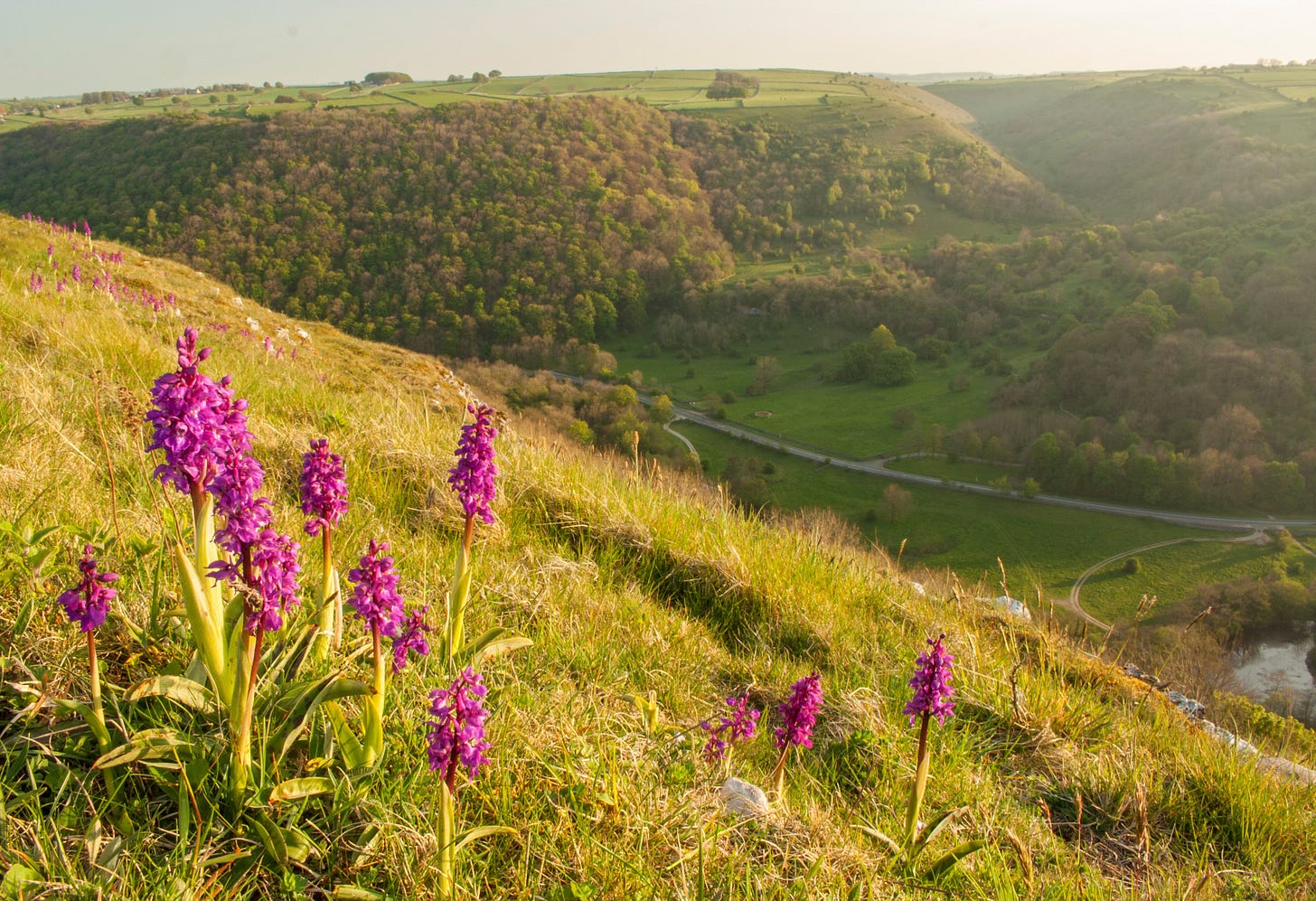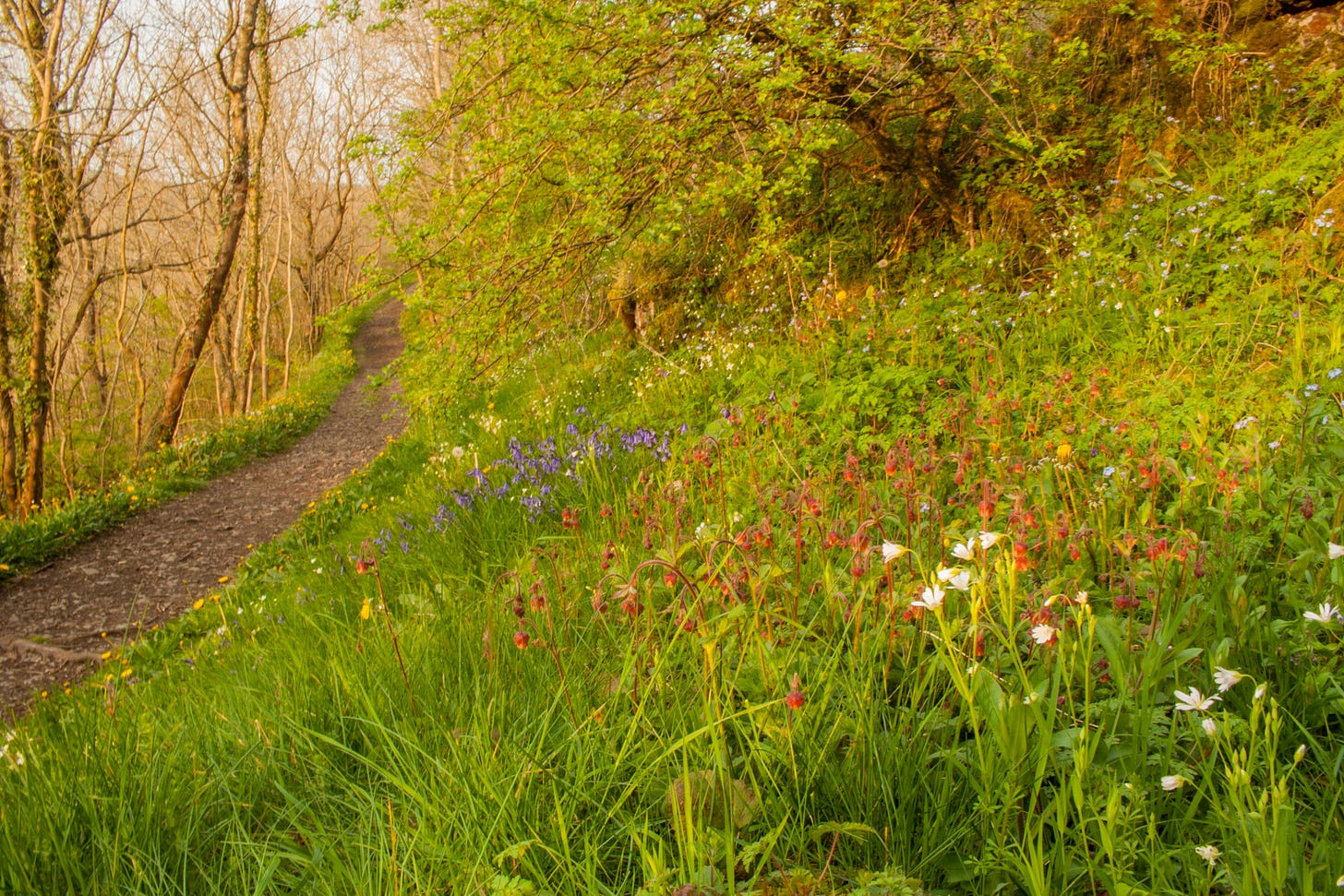
Introduction
The principal attribute by which Monsal Dale is widely recognised is that of its spectacular vista, landmarked by the residence of the Monsal Head Hotel. Elegant and enormous, the curvaceous form of this weatherbeaten accident of interglacial meltwaters has been inspiring curious visitors to commit their awe to paper for at least two hundred and fifty years. Today, in the epoch of the motor car and digital camera, in no doubt am I left, that deducing from the viewpoint’s daily popularity, memories of this majestic scene are being recorded for posterity, at the mere click of a button, in their millions, from the macro to the micro.
The floraphile in Monsal Dale can rejoice in the fact that the diversity of its habitats and their distinctive suites of herbs does not suffer from a dearth of scope: mining spoil long abandoned now yields bee orchids and leadwort; woodland glades that give up their ghostly, grinning toothwort; bilberry and heather aloft the dale’s arid brow comprise what is possibly relict heath; and the Victorian railway viaduct that today supports not locomotives but a train of old man’s beard. One plant exalted over all within the valley’s bounds is classified a species of national importance, accredited moreover, with the illustrious title of our county wild flower. Thriving no less in a geological landslip is the rare perennial, Jacob’s Ladder Polemonium caeruleum [see Floral Frolics Down The Derbyshire Dales: Winnats Pass]. Through the seasons these beautiful species besides many others embroider their transient colour onto Monsal Dale’s verdant canvas.
The unmistakable landmark of the Monsal Head Hotel and its panoramic vista is found four and a half kilometres north-west from the centre of Bakewell off the B6465 thoroughfare that links the villages of Ashford-in-the-Water with Wardlow.
Itineraries
There are three principle routes that more or less traverse the dale and which permit an exploration of its habitats entire: one a piece coursing each of its peripheral rims and another running parallel to its river. Except for the trail that terminates on the far edge of Fin Cop promontory, the principle routes may be interlinked to plan circular walks should the indefatigable visitor desire. Of the aforementioned routes that one from Monsal Head to Fin Cop is by far the least familiar. Even on the busiest of summer bank holidays for example, on this route, seldom will you encounter another soul. However, its relative anonymity by no means detracts from the satisfaction of its experience.
No fewer than three parking facilities are available in proximity to the Monsal Head Hotel, two of which are free. The officially designated pay and display bays are allocated to the rear and at the front of the hotel. Of the two free zones, one is a lay-by situated 300m or so north off the B6465 on the west side of the lane. The other is to the east on Butts Road between the hotel and Little Longstone along its northern kerb.
The main routes to the brim of Fin Cop and its adjunct trails to the viaduct and Hob’s House all begin at the front of the hotel - if the visitor can possibly prise themselves away from the mesmerising panoramic view ! Access to all areas is obtained on the western corner of the hair-pin bend of the road that descends to Upperdale and Cressbrook in front of Hob’s Cafe. To embark on the trail from Monsal Head to Fin Cop, at the roadside way marker simply proceed south-west for Ashford.

May through to June are the weeks that yield the ultimate rewards. The greater stitchwort, ground ivy, and dog violets thrive in luxuriant profusion beneath and above the mini-cliff along the left-hand margin of the trail. After no more than 500 metres the footpath departs the dale south to Ashford-in-the-Water. Ignore its exit and choose instead a fainter trail that begins not far from a nearby bench, and meanders through a tangle of mature scrub, guiding the explorer up the gentle ascent to the promontory rim. It also passes around the remains of the double rampart of an iron age fort on the way. The trail is tensely undulating with many pits and hillocks, but having reached the summit’s brim the virtue is its views: on the right: Monsal Dale, Hay, and Cressbrook Dales; and on the left: Taddington and Deep Dale (the one near Sheldon); a confluence of vast, labarynthine V-shaped corridors mantled with ashwoods or honey-brown grass, garnished with cliff and scree.
Follow the edge of Fin Cop around its ninety-degree bend from due west to due south. In uniforms of pale magenta, a troop of early purple orchids are displayed in open order along the perilous ledge of the southern-most crest of the scarp. Hardly is plant and panorama better juxtaposed. A late afternoon with a clear sky is an advantageous time to visit. The red shift in the setting sun lends each flower the aura of incandescent rubies.
Less conspicuous than the orchids but curious no less are the abundant packs of dog violets that roam astray the scarp’s craggy lip. One phenomenon worthy of note is that of the dense colonies of dog violets that crowd around at least three of the scattered, stunted hawthorns found on the brim furthest south not far from the aforementioned orchids. All of the colonies occur to the west of each of the shrubs’ trunks, and each colony has a diameter of 50 - 100 cms comprising between 50 - 100 individual plants. As well as early purple orchids and dog violets on Monsal Dale’s west-facing brim are noticeable colonies of cowslip, bluebell, crosswort, and yellow mountain pansy.
Another month in which this route warrants exploration is that of the month of August. Despite bearing the brunt of the prevailing weather and the precipitation that it brings, the shallow and stony soils of the promontory and the permeable rock on which they lie are unable to retain much moisture during the drier spells of the growing season. As a consequence, the grasses, formerly lush and green, of the abruptly-sloping relief, take on in late summer the texture of sandy fur. Rainfall on this lofty exposure is also responsible for leaching the calcium out of the uppermost soils leaving much of the ground acid. Smouldering atop of this toasted pelt are tatty scraps of bilberry and heather, relicts, possibly, of the heath that blanketed the bitter soils of the uncultivated tracts of the White Peak’s moorlands in the pre-modern era. Directly below the heather on the steep westward slopes thrive pockets of autumn gentian of an unusually robust size, and descending further still, occasional aquilegia, and the unexpected appearance of sheets of honeysuckle. Whilst beyond the heather to the south within the tufts of rougher grass peek posies of wild basil.
Deducing from the swept-back angle of the hawthorn scrub, this area receives more than its fair share of breeze which here, in August, is filled with flying ants !






Lovely